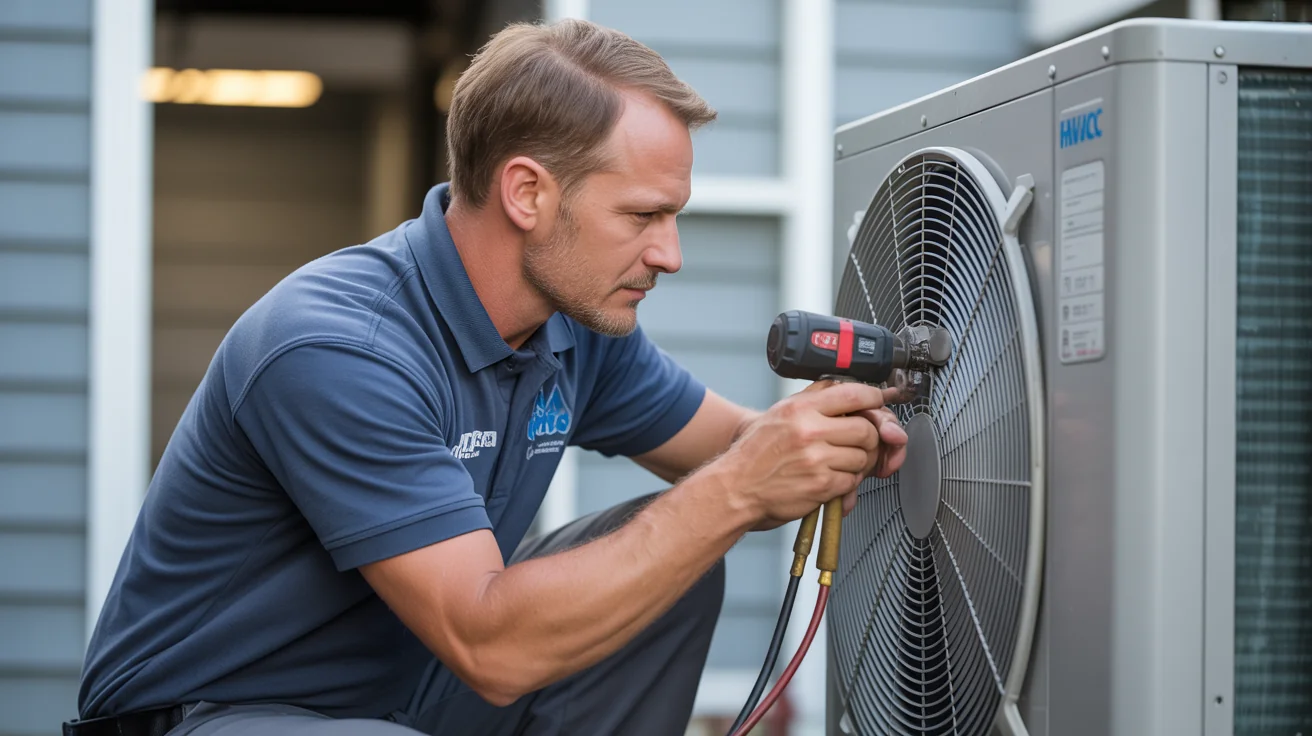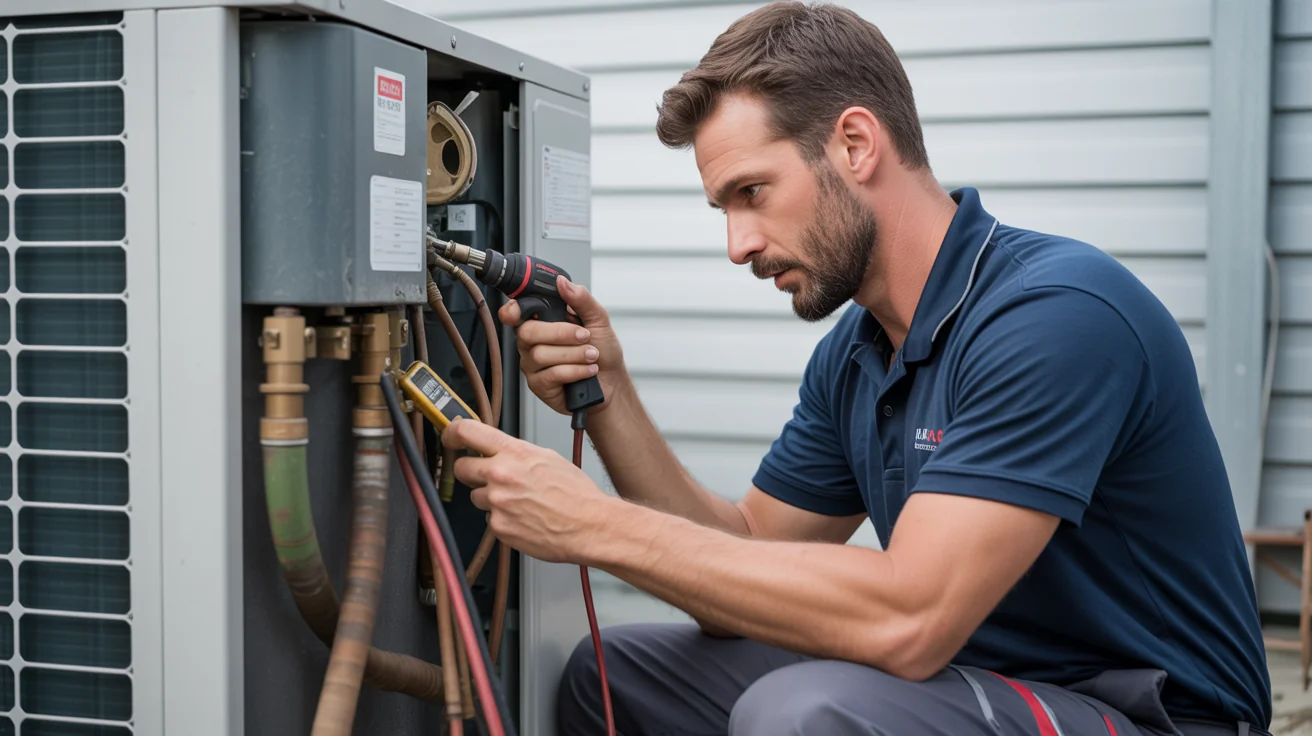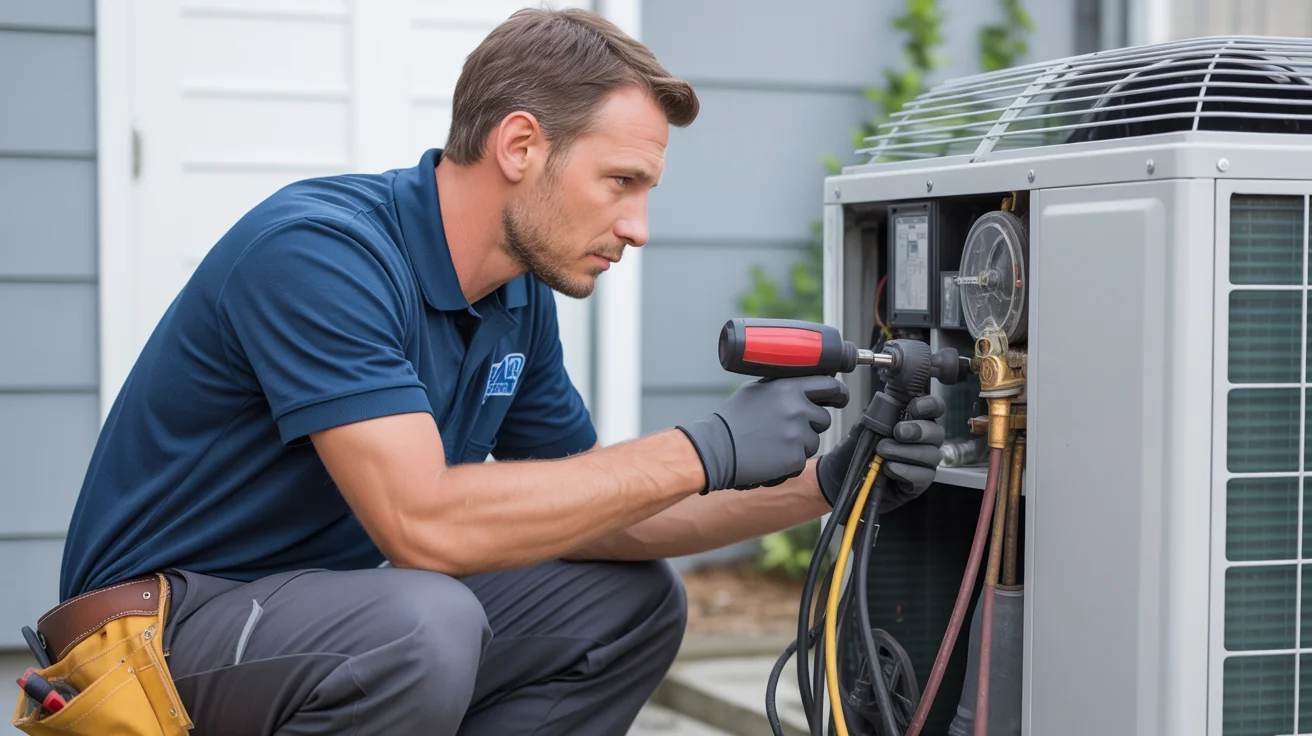AC Blowing Warm Air Causes and Fixes
AC Blowing Warm Air: Causes and Fixes — clear steps, practical detail, and when to call a pro in North Texas.

Your AC Just Became a Heater (And It’s 105°F Outside)
You know that sinking feeling when you walk into your house expecting sweet, cold relief from the Texas heat, and instead it feels like you just entered a sauna? Your AC is humming away like it’s working fine, but all it’s doing is pushing warm air around your house like some cruel joke.
I’ve been crawling around attics and wrestling with compressors across North Texas for the past 15 years, and this exact scenario plays out somewhere between Frisco and McKinney every single day once summer really kicks in. The worst part? Every minute you spend hoping it’ll magically fix itself, your house gets hotter and the repair bill gets bigger.
Just last Tuesday, I got one of those panicked calls from a young family out in Frisco. Their AC had been blowing warm air since 11 AM, and by the time I pulled into their driveway at 2:30, their house was sitting at 91°F. Mom was trying to keep their two-year-old calm while fanning Grandma, who was looking pretty peaked from the heat. They’d already made an emergency run to Walmart and dropped $40 on box fans that weren’t doing much besides moving hot air around.
When your AC decides to blow warm air during one of those North Texas scorchers, you’ve got maybe four to six hours before your house turns into something uninhabitable. If this is happening to you right now, don’t wait around hoping for a miracle – call our [emergency AC repair team](/services/ac-repair/) at (940) 390-5676.
Here’s Why North Texas Kills AC Systems
I’ve worked HVAC in Florida, spent two years in Arizona, and been here in Texas for over a decade now. Let me tell you something – nothing, and I mean nothing, beats North Texas for pure HVAC torture. Down in Florida, sure, it’s hot and sticky, but it’s pretty consistent. Arizona? It’s like working in an oven, but at least it’s a dry oven. Here in North Texas? We get the worst of everything wrapped up in one brutal package.
We’re asking our AC systems to run full-tilt for over 100 days straight when temperatures hit 95°F or higher. That’s like running a marathon every single day for three and a half months. Then you add in these dust storms that roll through and coat your outdoor unit in a thick layer of grime in just a few hours – not the gradual buildup you see in other places.
Our electrical grid gets hammered during peak summer, which means voltage spikes that can fry delicate components without warning. I’ve seen brand new capacitors get cooked by a power surge on a random Thursday afternoon. And those crazy temperature swings we get? Your system might be dealing with 105°F at 3 PM and then 70°F by midnight. All that expanding and contracting stress every single connection, every seal, every moving part. Add our infamous humidity on top of all that, and your poor AC is working twice as hard as it would anywhere else in the country.
What’s Actually Wrong (Most Likely)
After handling over 3,000 warm air emergency calls across North Texas, I can tell you that about 80% of the time, it’s one of these four culprits. And honestly, most people are pretty surprised by what actually causes the problem.
That air filter you forgot about – I can’t tell you how many times I’ve shown up to a house where the homeowner is convinced their compressor is shot, only to pull out an air filter that looks like it belongs in a vacuum cleaner bag. When your filter gets clogged up like a dirty carpet, absolutely zero air can move across your evaporator coil. No airflow means no heat removal, which means no cooling. Sometimes this even leads to frozen evaporator coils, which seems weird but makes perfect sense once you understand the physics.
A dead capacitor – This little $15 part is what kicks your compressor into gear, and it’s the number one component failure I see in Texas heat. When it goes bad, your outdoor unit will sit there humming like it’s trying really hard, but your compressor won’t actually start. You’ll hear all this noise but get zero cooling.
Refrigerant leak – Your AC system is sealed tight when it’s installed, but after years of those crazy temperature swings we get, connections can work loose and tiny leaks develop. When your system starts running low on refrigerant, it’ll blow increasingly warm air while slowly cooking your compressor from the inside out.
Thermostat acting up – This happens way more often than most people realize. Sometimes these things just decide to stop communicating properly with your system, or they start reading temperatures wrong. Before you assume it’s something major, take a look at our complete troubleshooting guide to rule out the simple stuff.
Try These Things First (Takes 5 Minutes)
Before you call anyone or start panicking about huge repair bills, grab a cold drink and spend five minutes checking these basic things. I’ve had plenty of calls where the homeowner could’ve saved themselves a service call with just a couple minutes of detective work.
Start with your air filter – pull it out and actually look at it. If you can’t see light through it, or if it looks like something you’d find at the bottom of a lint trap, replace it right now. Don’t wait, don’t put it back in “just for today.” A $3 filter can save you a $300 repair bill.
Next, walk over to your thermostat and double-check the obvious stuff. Is it actually set to “COOL” and not “HEAT” or “AUTO”? Is the target temperature lower than what your house feels like right now? I’ve driven across town to find someone’s thermostat was set to 78°F when their house was already 80°F – the system was working perfectly, just doing exactly what it was told to do.
Now head outside to your AC unit and see if that big fan on top is spinning. If the fan’s not moving but you can hear the unit humming or buzzing, you’ve likely found your problem – probably that capacitor I mentioned earlier.
While you’re out there, clear away any grass, weeds, or random junk that might be crowding your outdoor unit. These things need space to breathe, and I’ve seen units completely choked off by enthusiastic landscaping.
If your outdoor coil looks really dusty or caked with debris, go ahead and gently spray it down with your garden hose. Don’t use high pressure – just a gentle rinse to get the worst of it off.
Oh, and if you see any error codes blinking on your thermostat or indoor unit, snap a picture with your phone before you do anything else. Trust me, it’ll save you $75 in diagnostic fees when you show it to the technician.
Stop Right Here and Call a Pro If You See
Okay, look – I’m all for DIY troubleshooting, but there are some situations where you need to stop everything and call a professional immediately. Don’t be a hero with these ones.
Any burning smell or sparks – The second you smell something burning or see any sparks anywhere near your system, shut off your AC at the breaker and call emergency repair right now. I’ve seen house fires start from faulty electrical connections in HVAC systems, and it’s not worth the risk.
Water pooling anywhere near electrical panels – Electricity and water are a deadly combination. If you see water near any electrical components, don’t touch anything. Step away and call us. I’ve been shocked more times than I care to remember, and trust me, it’s not fun.
Ice forming anywhere on your system – I know this seems backwards – ice when you want cooling? – but ice formation means your system is broken and potentially damaging itself. Don’t try to scrape it off or speed up the melting process. Read our frozen coil safety guide first, but honestly, just call us.
Your circuit breaker keeps tripping – If your AC keeps kicking the breaker, it’s pulling way more power than it should. That usually means a motor is failing or there’s a serious electrical problem. Each time it trips, you’re risking damage to other components.
What I’ll Do When I Show Up
When I roll up to your house, I’m not just going to poke around and guess what’s wrong. I’ve got a systematic approach that usually takes about 30 minutes and involves about $2,000 worth of diagnostic equipment. Here’s what that looks like:
First thing I do is test your airflow with a manometer – this little device tells me exactly how much air is moving through your system. You’d be amazed how many people are shocked to learn their system is moving about half the air it should be. Sometimes it’s a clogged filter, sometimes it’s ductwork problems, but either way, it’s killing your cooling capacity.
Next, I break out the multimeter to test your capacitors and contactors. These components fail constantly in Texas heat – I probably replace more capacitors than any other single part. A bad capacitor might let your system hum and vibrate, but your compressor won’t actually start.
Then I hook up my refrigerant gauges to measure pressures and temperatures at different points in your system. This tells me whether you’re low on refrigerant, have a restriction somewhere, or if your compressor is starting to fail. The pressure readings tell a story if you know how to read them.
Testing your thermostat and control board is more complex than most people realize. Sometimes the thermostat reads temperatures correctly but doesn’t communicate properly with your system. Other times the control board gets flaky and sends mixed signals to different components.
Finally, I check your drain system because a clogged condensate drain can actually shut down your entire system as a safety measure. I’ve seen perfectly good AC systems completely disabled by a backup that could be fixed with a wet-dry shop vacuum.
Basically, I’m playing detective with all this test equipment, following clues until I find the root cause. And yeah, that’s exactly why diagnostic fees exist – this isn’t just someone eyeballing your system and taking a wild guess.
How to Never Deal With This Again
After dealing with thousands of these warm air emergencies, I can tell you that most of them are totally preventable. Here’s how to keep your AC running cold all summer long.
Stop buying cheap filters – I see this mistake constantly. Those thin, blue fiberglass filters you get at the grocery store? They’re basically useless. They catch maybe the biggest chunks of debris but let everything else sail right through to clog up your evaporator coil. Invest in a good MERV 8-11 pleated filter and change it every month during summer – every single month. I know it feels like a lot, but in Texas heat with our dust and pollen, your filter is working overtime. Check out our [maintenance schedule guide](/blog/summer-ac-maintenance-schedule-texas-heat/) to see exactly what you should be doing when.
Get your ductwork fixed – If you’ve got rooms that are always too hot or too cold, your ductwork is probably leaking conditioned air into your attic or crawl space. I’ve seen houses where 30-40% of the cool air never makes it to the rooms because it’s escaping through leaky ducts. Our [duct repair team](/services/duct-repair-sealing/) can track down these leaks and seal them up. Good ductwork can literally boost your AC efficiency by 30% or more.
Schedule tune-ups before you actually need them – Look, I get it. Nobody wants to spend money on something that’s working fine. But here’s the thing – your AC is like your car. Would you drive 60,000 miles without ever changing the oil or checking the brakes? Your HVAC system needs professional maintenance twice a year to catch small problems before they turn into expensive emergencies. A $150 tune-up can prevent a $1,500 compressor replacement.
Quick Answers to Questions You’re Probably Asking
Is it safe to keep running it? That depends on what you’re seeing. If there’s any burning smell, water pooling near electrical components, or ice formation anywhere on the system, shut it down immediately. Otherwise, you’re not going to hurt anything by letting it run, but you’re basically just circulating warm air and running up your electric bill for no reason.
Why did this happen right now? Nine times out of ten, something was already on its way to failing, and the extreme heat just pushed it over the edge. Or your air filter has been getting progressively more clogged until finally it reached the point where no air can move through your system. AC problems don’t usually happen out of nowhere – there are usually warning signs that get ignored until they become emergencies.
Will it fix itself? I wish I could tell you yes, but AC systems don’t heal themselves. In fact, the opposite is true – problems get worse the longer you wait. A simple refrigerant leak that might cost $200 to fix today could destroy your $2,000 compressor if you let it go for months. The sooner you address the problem, the less it’s going to cost you in the long run.
More Help When Your AC Acts Up
Look, AC problems happen to everyone – even us HVAC techs deal with this stuff at our own houses. Don’t beat yourself up about it. Here are some other resources that might help you get through this.
When Things Go Really Wrong
If you’re dealing with something more serious than just warm air, check out My AC Isn’t Cooling At All for a complete troubleshooting walkthrough. And if you’re staring at ice forming on your system (yes, that really happens), There’s Ice On My AC (What?!) will walk you through what to do safely. Want to know what you’re looking at cost-wise? How Much Will This Cost Me? gives you real repair costs so you can spot a ripoff from a mile away.
Professional Help
Sometimes you just need to call in the cavalry. Our Emergency AC Repair team is available 24/7 because AC emergencies don’t care if it’s 2 AM on a Sunday. For less urgent issues, our Same-Day AC Repair service can usually get most problems fixed the same day you call. And if you want to avoid all this drama in the future, check out our AC Tune-Ups – it’s the kind of maintenance that actually prevents problems instead of just cleaning stuff.
Seasonal Stuff
Want to stay on top of things year-round? Our [Summer Maintenance Schedule](/blog/summer-ac-maintenance-schedule-texas-heat/) tells you exactly what to do each month to keep your AC running strong through Texas heat. And our Pre-Summer Tune-Up guide helps you get everything ready before the really brutal temperatures hit.
Need help right now? We cover Frisco, Plano, McKinney, Allen, and all the surrounding North Texas areas. Call (940) 390-5676 and we’ll get someone out to you fast. No games, no runaround – just honest HVAC service from people who actually know what they’re doing.
Need Professional HVAC Service?
Our certified technicians are ready to help with any HVAC needs in North Texas




